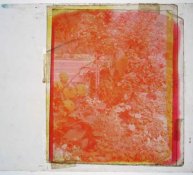Hello,
I'm looking for information on a type of color process that seems particularly rare. The object image consists of two sheets of mica (approx. 5 x 6 cm) superimposed on a thin frosted glass. The image is revealed by the juxtaposition of two colored layers (magenta and yellow). It apparently lacks the third layer of cyan to perfect the rendering of color.
The trichromy process was revealed by Louis Ducos du Hauron in 1869. In his statement he also proposed a solution to use mica (good for its low thickness and transparency) as a picture.
Today, I would be willing to learn if some collections around the world and especially in France has similar examples of this technique.
Thank you very much for the help you can provide me.
PAK
I'm looking for information on a type of color process that seems particularly rare. The object image consists of two sheets of mica (approx. 5 x 6 cm) superimposed on a thin frosted glass. The image is revealed by the juxtaposition of two colored layers (magenta and yellow). It apparently lacks the third layer of cyan to perfect the rendering of color.
The trichromy process was revealed by Louis Ducos du Hauron in 1869. In his statement he also proposed a solution to use mica (good for its low thickness and transparency) as a picture.
Today, I would be willing to learn if some collections around the world and especially in France has similar examples of this technique.
Thank you very much for the help you can provide me.
PAK











